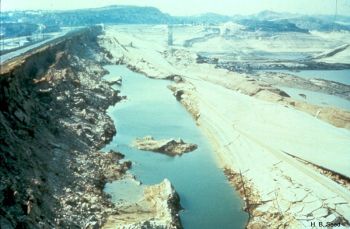Seismic

|
| Learn more about the failure of Lower San Fernando Dam during a seismic event at DamFailures.org |
“The scope of the seismic hazard study at a site depends on the seismicity of a region or site-specific considerations, the types of structures involved, and the consequences of failure. The design and evaluation of dams for earthquake loading should be based on a comparable level of study and analysis for each phase of the study (seismotectonic, geological, site, geotechnical, and structural investigations) and that level of study should reflect both the criticality of the structure and the complexity of the analysis procedures".[1]
"Risk management and risk analysis can be used in making seismic evaluation of dams. These methods may be applied to help accomplish the following: prioritize safety evaluations when considering a large number of dams; evaluate the benefits of alternative remedial measures; select load levels; and evaluate the structural response. Risk management and risk analysis tools may also be applied as a framework for the overall seismic evaluation leading to the final decisions. The application or risk assessment procedures in a comprehensive and quantitative manner is used as a tool by various agencies to improve the quality and consistency of decisions on the seismic safety of structures. It is recognized that risk is considered in the application of engineering judgement even when more formal risk analysis procedures are not employed". [1]
A Seismic Hazard Analysis (SHA) is an assessment of naturally occurring earthquakes using faults or past earthquakes to predict the hazard. The purpose of conducting a seismic hazard analysis is to develop seismic design criteria for use in evaluating the seismic response of a given structure or facility. Presently, there are three ways by which the design requirements can be ascertained: use of local building codes; conducting a Deterministic Seismic Hazard Analysis (DSHA); or performing a Probabilistic Seismic Hazard Analysis (PSHA).
Determining which of the three above mentioned analyses that need to be completed depends on the owner or regulatory commission in charge of the structure that is being designed. It is important to recognize that different agencies, local cities, counties, states or countries could have separate design guidelines that may need to be reviewed to insure that all guidelines are being followed.
Types of Seismic Evaluations
Required Data
Types of Analyses
Examples
![]() Learn more about the importance of accounting for seismic loadings in dam designs (DamFailures.org)
Learn more about the importance of accounting for seismic loadings in dam designs (DamFailures.org)
![]() Learn more about the failure of Lower San Fernando Dam during a seismic event (DamFailures.org)
Learn more about the failure of Lower San Fernando Dam during a seismic event (DamFailures.org)
Best Practices Resources
Trainings
![]() On-Demand Webinar: Current Trends in the Seismic Analysis of Embankment Dams
On-Demand Webinar: Current Trends in the Seismic Analysis of Embankment Dams
![]() On-Demand Webinar: Seismic Stability Evaluation of Earth Dams
On-Demand Webinar: Seismic Stability Evaluation of Earth Dams
![]() On-Demand Webinar: Earthquake Hazards, Ground Motions and Dynamic Response
On-Demand Webinar: Earthquake Hazards, Ground Motions and Dynamic Response
Citations:
Revision ID: 3823
Revision Date: 09/30/2022
